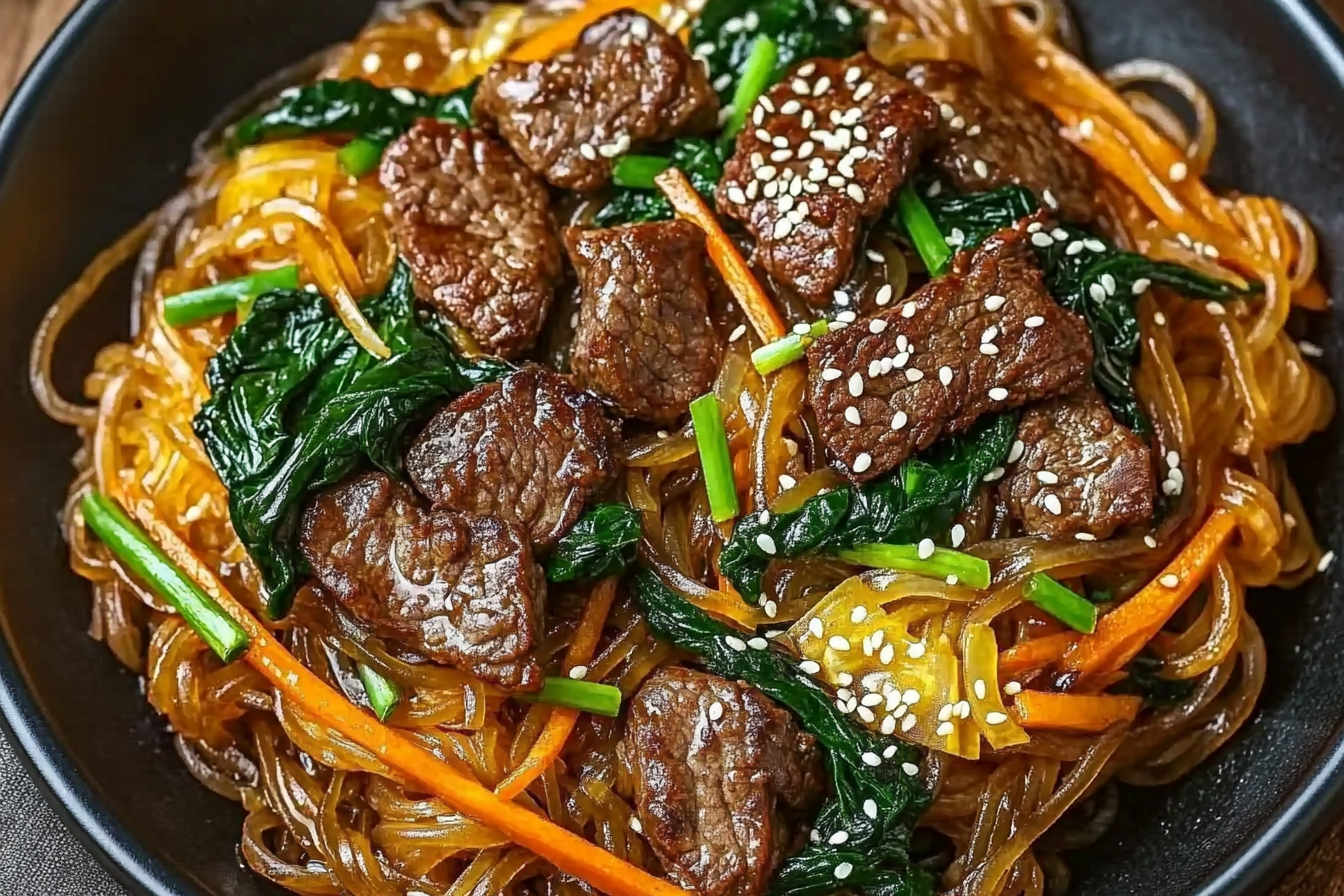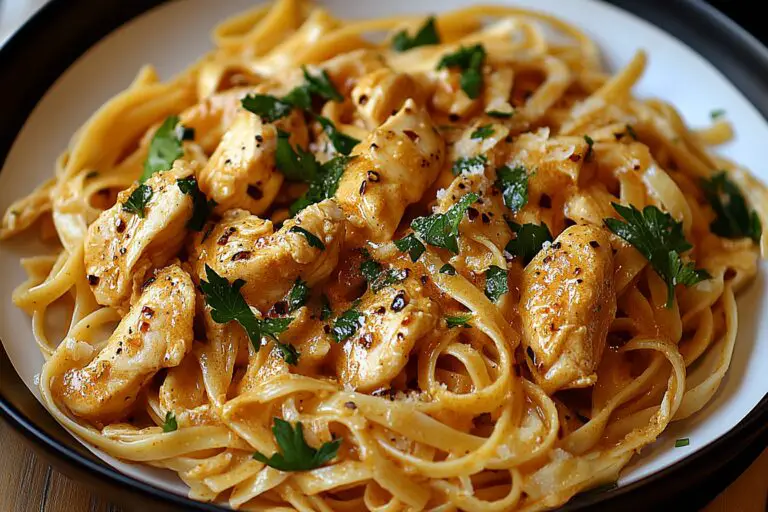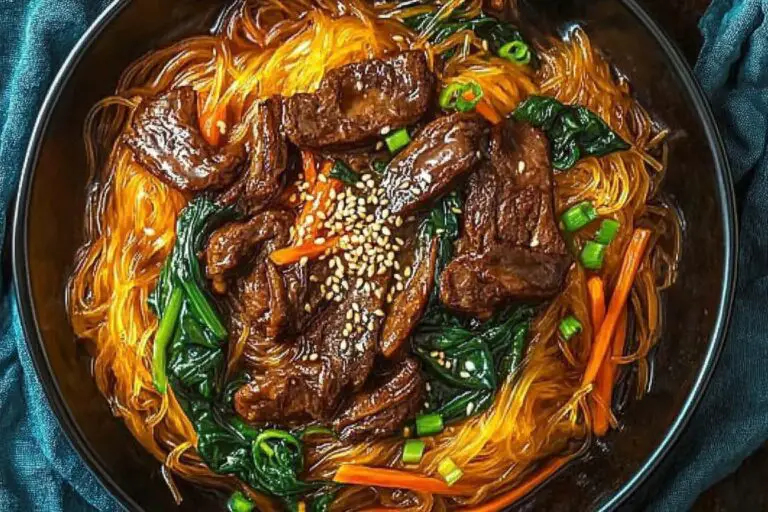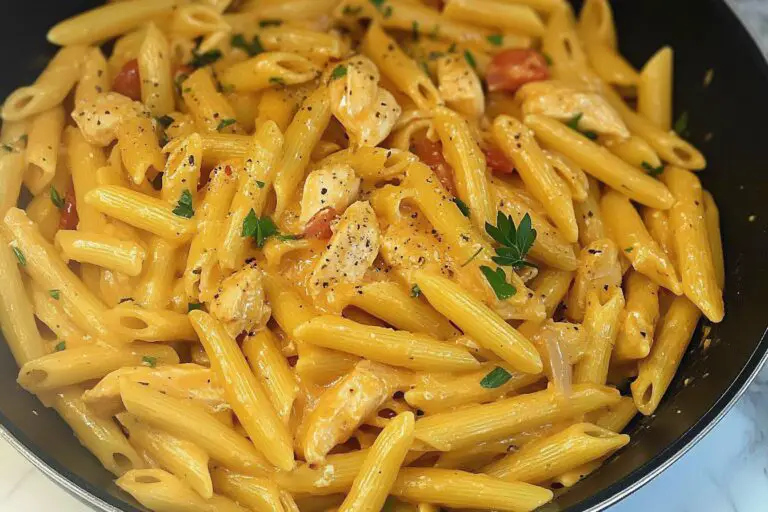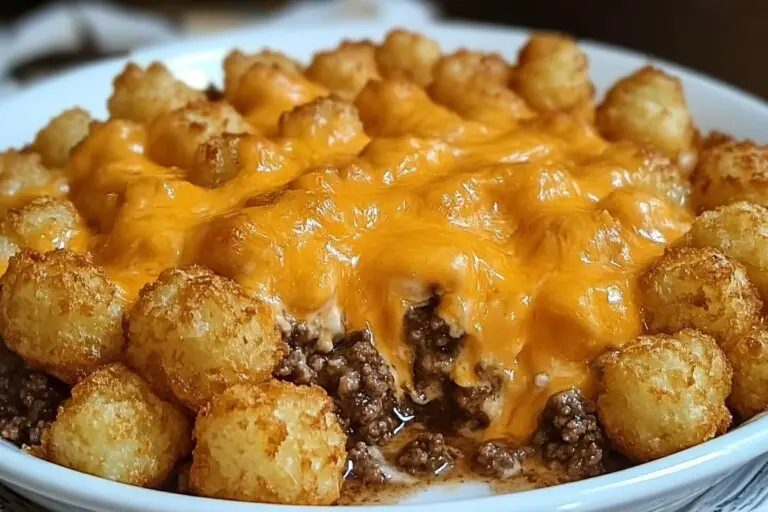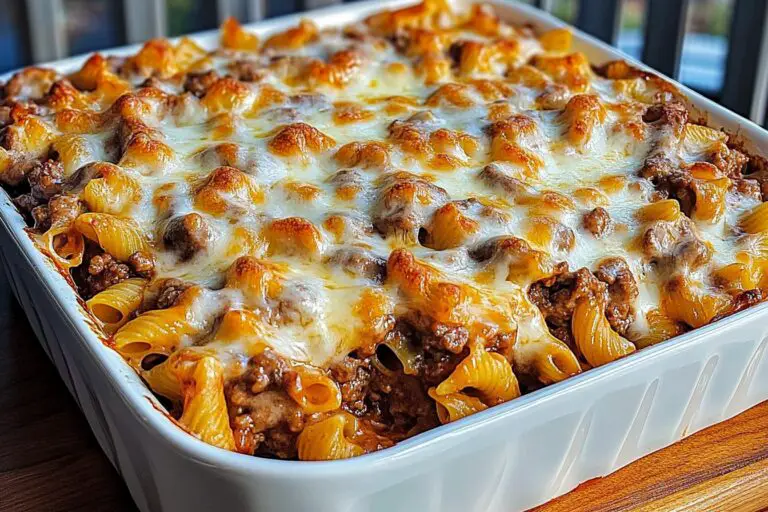Japchae Noodle Stir-Fry
Introduction
Japchae is a traditional Korean dish made from sweet potato starch noodles, also known as dangmyeon. This stir-fried delicacy is packed with an array of colorful vegetables and often includes beef or other proteins, making it a vibrant and delicious meal. The dish is known for its slightly sweet and savory flavor profile, thanks to a special sauce made from soy sauce, sesame oil, and sugar. Japchae is a popular dish in Korean cuisine, often served during special occasions and celebrations.
Detailed Ingredients with measures
– Sweet potato starch noodles (dangmyeon) – 8 oz
– Beef (or protein of choice) – 6 oz, thinly sliced
– Spinach – 4 oz
– Carrots – 1 medium, julienned
– Onion – 1 medium, sliced
– Bell pepper – 1 medium, sliced
– Mushrooms (shiitake or any variety) – 4 oz, sliced
– Sesame oil – 2 tablespoons
– Soy sauce – 3 tablespoons
– Sugar – 1 tablespoon
– Garlic – 2 cloves, minced
– Sesame seeds – for garnish
– Green onions – for garnish (optional)
Prep Time
Preparation time for japchae takes approximately 30 minutes. This includes soaking the noodles, chopping the vegetables, and marinating the meat if desired.
Cook Time, Total Time, Yield
The cooking time for japchae is about 15 minutes. Therefore, the total time from preparation to serving is roughly 45 minutes. This recipe yields about 4 servings, making it an ideal dish for family gatherings or friendly get-togethers. Enjoy your homemade japchae, bursting with flavor and texture!

Detailed Directions and Instructions
Step 1: Soak the Glass Noodles
Soak the sweet potato glass noodles in warm water for 30 minutes until they are soft. Drain and set aside.
Step 2: Prepare the Vegetables
Julienne the carrots and bell peppers. Finely chop the onion and garlic. Slice the mushrooms and green onions.
Step 3: Cook the Vegetables
Heat vegetable oil in a frying pan over medium heat. Add the onion and garlic. Sauté until they are fragrant. Next, add the carrots and bell peppers, stir-frying for about 3-4 minutes. Add the mushrooms and cook until softened.
Step 4: Cook the Noodles
In a separate pot, boil water and add the soaked glass noodles. Cook for about 5-6 minutes until they are chewy. Drain and rinse with cold water.
Step 5: Combine Ingredients
In the frying pan with the vegetables, add the cooked glass noodles. Mix well and stir-fry, allowing the noodles to soak up the flavors.
Step 6: Season the Dish
Add soy sauce, sesame oil, and sugar to the noodle mixture. Stir until everything is evenly coated. Cook for an additional 2-3 minutes.
Step 7: Garnish and Serve
Sprinkle sesame seeds and chopped green onions on top. Serve hot and enjoy your Japchae!
Notes
Ingredient Substitutions
Feel free to substitute vegetables based on your preference or availability. Common alternatives include zucchini or spinach.
Storage Instructions
Japchae can be stored in an airtight container in the refrigerator for up to 3 days. Reheat before serving.
Serving Suggestions
Japchae can be served as a main dish or as a side. It pairs well with rice and other Korean dishes.
Dietary Considerations
This dish is naturally gluten-free when using gluten-free soy sauce, making it suitable for those with gluten sensitivities.
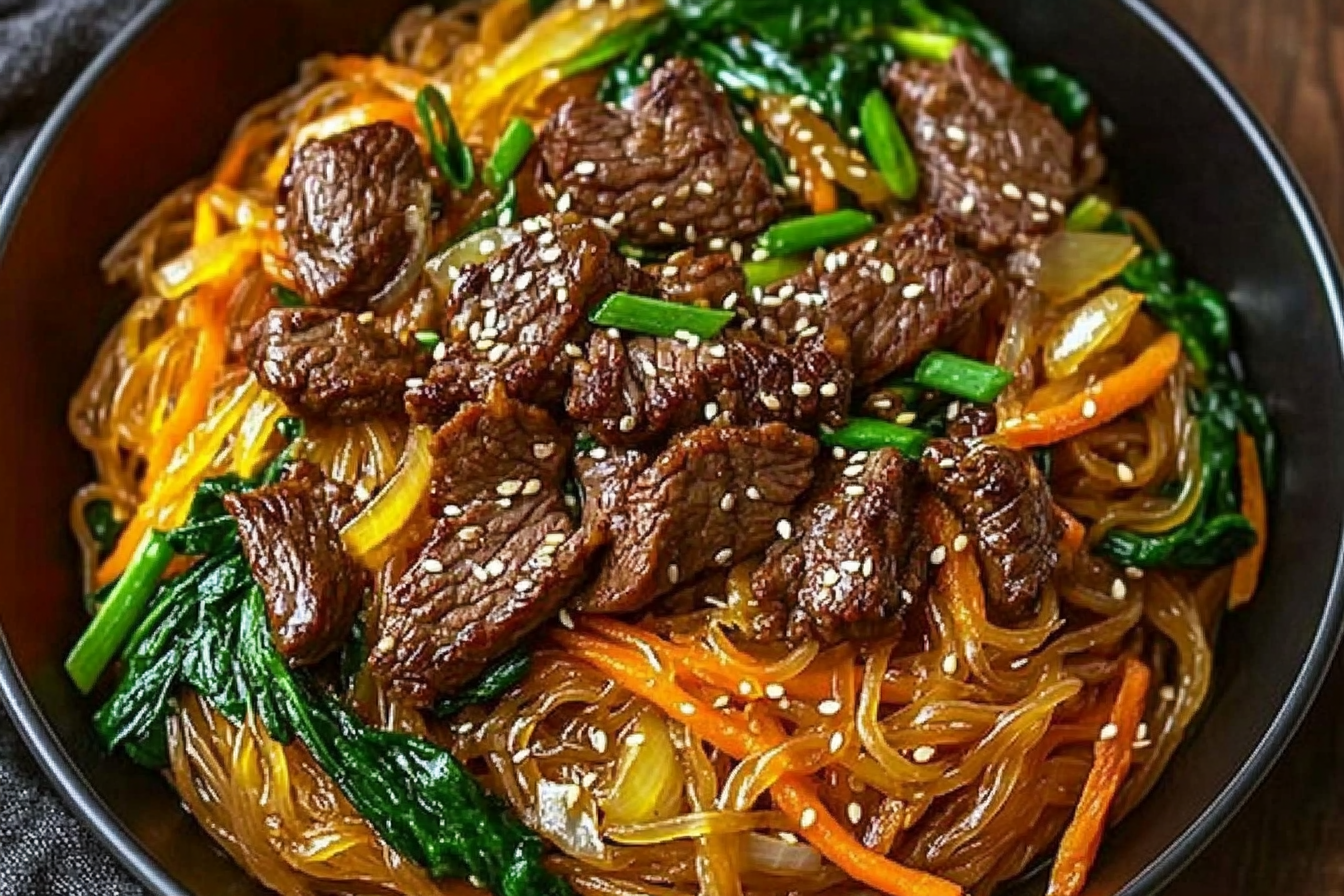
Cook techniques
Sautéing
Sautéing is a technique used to cook ingredients quickly in a small amount of oil or fat over relatively high heat. In this method, the food is often cut into small, uniform pieces to ensure even cooking. In the case of japchae, vegetables and meat are sautéed separately before being combined with the noodles.
Blanching
Blanching involves briefly boiling vegetables or noodles and then quickly cooling them in ice water. This process helps to maintain the color and texture of the ingredients, making them vibrant and crunchy. For japchae, you might blanch the vegetables to enhance their flavor and preserve nutrients.
Stir-frying
Stir-frying is similar to sautéing but typically uses higher heat and involves constant stirring to cook the food evenly. This technique is essential for making japchae, as it helps in combining the flavors of the meat, vegetables, and noodles while achieving a desirable texture.
Marinating
Marinating involves soaking meat or vegetables in a seasoned liquid before cooking. This enhances flavor and tenderizes the ingredients. For japchae, marinating the meat with soy sauce and other seasonings before sautéing can elevate the dish.
Mixing
Mixing is the process of combining ingredients to ensure an even distribution of flavors and textures. In japchae, once all the components are cooked separately, they are mixed together with the noodles and sauce to create a harmonious dish.
FAQ
What can I substitute for sweet potato noodles in japchae?
You can substitute sweet potato noodles with other types of noodles, such as cellophane noodles or even rice noodles, though the texture and flavor may vary slightly.
Can I make japchae ahead of time?
Yes, japchae can be made ahead of time and stored in the refrigerator. It is best to reheat it gently before serving to maintain the texture of the noodles.
Is japchae gluten-free?
Japchae can be gluten-free if you use gluten-free soy sauce and ensure that all other ingredients are also gluten-free. Traditional sweet potato noodles are naturally gluten-free.
How long can I store leftovers of japchae?
Leftover japchae can be stored in an airtight container in the refrigerator for up to 3 days. Reheat on the stove or in the microwave before serving.
What are the best vegetables to use in japchae?
Common vegetables used in japchae include spinach, carrots, onions, and bell peppers. However, you can also add mushrooms, zucchini, or any of your favorite vegetables.
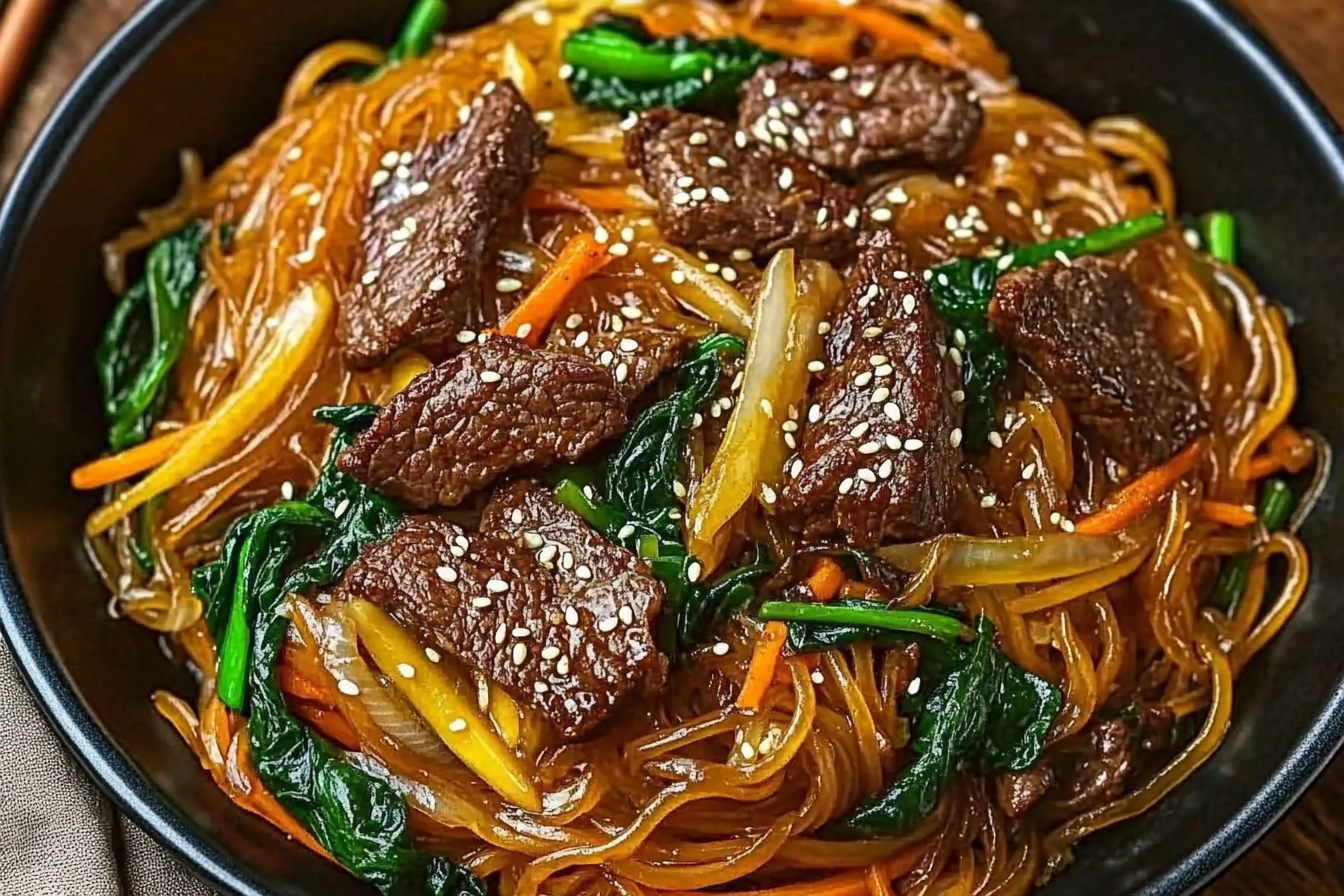
Conclusion
Japchae is a delightful Korean dish that offers a wonderful combination of flavors and textures. The sweet potato noodles, along with a variety of colorful vegetables and proteins, create a nutritious and satisfying meal. Whether served as a side dish or the main course, Japchae is sure to please a crowd and is perfect for any occasion.
More recipes suggestions and combination
Vegetable Stir-Fry
Combine seasonal vegetables such as bell peppers, broccoli, and carrots for a vibrant stir-fry that pairs well with Japchae.
Korean Beef Bulgogi
Serve beef bulgogi alongside Japchae for a hearty meal that boasts layers of flavor with marinated, grilled beef.
Spicy Korean Chicken
Opt for spicy Korean chicken to add a kick alongside your Japchae for those who enjoy a bit of heat in their dishes.
Kimchi Fried Rice
Prepare kimchi fried rice as a side dish to complement the sweet and savory taste of Japchae.
Tofu Stir-Fry
For a vegetarian option, try a tofu stir-fry with soy sauce and garlic to serve alongside the Japchae.
Egg Roll or Spring Roll
Egg rolls or spring rolls can provide an appealing crunchy texture that balances the soft noodles in Japchae.
Miso Soup
A light and comforting miso soup can be a great starter dish served before the main Japchae dish.
Sesame Spinach Salad
Pair Japchae with a sesame spinach salad for a fresh and healthy contrast to the richness of the noodles.

